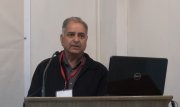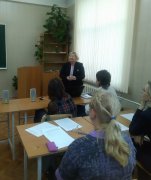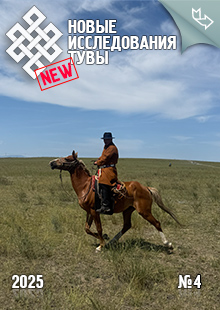 29 ноября 2017 г. на базе
кафедры философии Алтайского государственного аграрного
университета состоялся российско-индийский on-line семинар. Он прошел
в рамках проекта «Алтай и Гималаи как уникальные
культурно-биосферные регионы Евразии: поиск
общих ценностей, эколого-экономических стратегий, социокультурных параллелей»,
при финансовой поддержке РФФИ и администрации Алтайского края (грант №
16-13-22002).
29 ноября 2017 г. на базе
кафедры философии Алтайского государственного аграрного
университета состоялся российско-индийский on-line семинар. Он прошел
в рамках проекта «Алтай и Гималаи как уникальные
культурно-биосферные регионы Евразии: поиск
общих ценностей, эколого-экономических стратегий, социокультурных параллелей»,
при финансовой поддержке РФФИ и администрации Алтайского края (грант №
16-13-22002).Участники
проекта: преподаватели АГАУ, АлтТГУ им. И.И. Ползунова, АГУ, Института
философии и права СО РАН (г. Новосибирск). С индийской стороны участвовали
сотрудники Института комплексных гималайских исследований Университета штата
Химачал-Прадеш, а также представители Общества защиты
экологического и культурного разнообразия Индийских Гималаев «Калп» (г. Шимла, штат Химачал-Прадеш).
Участники проекта собрались,
чтобы обсудить итоги двухлетней исследовательской
работы. В качестве рабочей гипотезы было выдвинуто предположение, что алтайский
и гималайский горные регионы, несмотря на территориальную удаленность, имеют
много общих черт в хозяйственно-экономическом и культурном развитии. В ходе
компаративистских исследований участники проекта установили, что этому
способствуют не только природно-климатические факторы, но и
культурно-исторические. Во время экспедиционных поездок по Алтаю и Гималаям были
проведены социологические опросы, которые позволили оценить степень общности и
сохранности традиционной системы ценностей народов, проживающих на этих
территориях. В силу сложившихся обстоятельств, среди которых немалую роль
играет и удаленность от крупных агропромышленных комплексов, перед жителями
горных поселений стоит непростая задача: на основе интеграции традиционных
знаний и современных научных инноваций развить оптимальные формы
хозяйствования, чтобы добиться улучшения качества жизни местного населения при
сохранении уникальных горных экосистем.
Одним из результатов
работы участников проекта стала разработка научно-практических рекомендаций для
органов государственной власти и бизнес-структур Алтайского края и штата
Химачал-Прадеш, которые обсудили и утвердили участники семинара.
Также в ходе семинара
были награждены победители студенческого заочного конкурса научно-исследовательских
работ "Дорогами дружбы и взаимного познания”, посвященного 70-летию
установления дипломатических отношений между Россией и Индией. Первое место заняла Филимоненко Анна (гр. 155) с
темой: "Индийские мотивы в государственной символике Российской
Федерации". Второе место –
Золотарева Анастасия, гр.652. Тема ее исследования: «Древнее и
современное знание Индии: проблема сохранения преемственности». Третье место – Овчарова Александра и
Мирошниченко Влада (гр. 4623) с докладом: «Алтай и Гималаи: общие
экологические проблемы горных регионов». Благодарности за участие получили Бодрошева Елизавета, гр. 155 (Тема: «Образ грифона на гербе Республики
Алтай: индийские параллели»), Сидорских Юлия, гр. 155 (Тема «Алтай-Гималаи:
мифологические параллели»), Салмова Александра, гр.4623 (Тема
«Современные экологические организации Индии»).
Совместная работа сибирских и индийских
ученых будет продолжена в рамках
международной научной группы
«Алтайско-Гималайская Инициатива». В частности, запланирован визит индийской
делегации в июне 2018 года на 9-ую Международную научно-практическую
конференцию «Евразийство: теоретический потенциал и практические приложения». Т.А. Артамонова, зам директора по НР
Центра гуманитарного образования
Т.А. Артамонова, зам директора по НР
Центра гуманитарного образования Алтайского государственного аграрного университета, г. Барнаул
Оn-line Indian-Russian Seminar:
"Altai and the Himalayas as Unique Cultural and Biosphere Regions of Eurasia”
Organizers: Altai State Agricultural University, KALP Foundation
29 of November 2017, Lecture Hall of Scientific Council of Altai State Agricultural University, 16.00
Main Scientific Reports from the Indian Side:
1) Prof. Pankaj Mahayan Gupta, Institute of Integrated Himalayan Studies Himachal Pradesh University, Summer Hill, Shimla: "Indigenous Healthcare Traditions of Trans-Himalaya”
2) Dr. Vijay Kumar Sharma, Institute of Integrated Himalayan Studies Himachal Pradesh University, Summer Hill, Shimla: "Incredible Traditions and Amazing Cultural Practices of Kinnauras”
Printed reports, presented at the Seminar
1) Prof. O. C. Handa, Senior Fellow of the ICHR and fellow of US-based Infinity Foundation, the Director of Indus-Infinity Foundation&Senior Editor of the History of Indian Science&Technology Series (HIST), India. AN OVERVIEW OF THE BUDDIST ARCHAEOLOGY IN WESTERN HIMALAYAN REGION
2) R.S. Sambyal, a lecturer (Environment Sciences) at Government Boys Senior Secondary School, District Jammu, Jammu& Kashmir, India. KINNAUR’S ECOLOGICAL TROVE UNDER THE THREATS OF DEVELOPMENT
3) Dr. M. Sharma, Department of Music, Himachal Pradesh University, Summer Hill, Shimla, India. FOLK MUSICAL INSTRUMENTS OF TRIBAL AREA OF KINNAUR
Main Scientific Reports from the Russian Side:
1) Andrey Vladimirovich Ivanov, doctor of philosophy, professor, Head of the Chair of Philosophy of the Altai State Agricultural University: "Facts and foundations of economic and socio-cultural parallels between Altai and the Himalayas”
2) Michail Yryevich Shishin, doctor of philosophy, professor, Director of Institute of Great Altai of Altai State Technical University: "Petroglyphic heritage of Altai and the Himalayas: common and special”
3) Yuri Vladimirovich Popkov, doctor of philosophy, professor, Head of the Sector of ethno-social research of the Institute of Philosophy and Law, Siberian branch of the Russian Academy of Sciences: "Life world of the Uimon valley and Kinnaur in the comparative perspective”
4) Valentina Aleksandrovna Kundius, doctor of economy, professor, Head of the Chair of Economy of APC of the Altai State Agricultural University: "Organic agriculture and sustainable development of mountain areas in modern conditions”
Abstracts from the Russian Reports:
A.V. Ivanov "Facts and foundations of economic and socio-cultural parallels between Altai and the Himalayas”
The article analyzes the facts of economic, ethnic and cultural parallels between the great mountain regions of Eurasia – Altai and the Himalayas. There are three objective reasons for such a parallelism: the community of the biospheric conditions, the unity of historical memory and direct cultural contacts of the peoples of the two regions. 1) Biospheric conditions..The commonality of external biosphere calls generates close forms of economic and sociocultural responses. Deposits of ores and biosphere reserves of the Altai and the Himalayas objectively turned them into economic centers of agriculture (foothill areas and river valleys are characterized by good hydration and quality of chernozems), domestication of wild animals and development of phytotherapy.Mountains are represented in the traditional mind as universal life-keepers, as strongholds and pillars of world existence, on which human life directly depends. It is not surprising that the Altai Mountains and the Himalayas - their peaks, valleys and rivers - were deified in the mythological and epic traditions, endowed with supernatural power and grace. The Himalayas are the sacred mountains ruled by the god-ruler Himalaya; Altai - the golden mountains led by Kaan-Altai. Life in the mountains determines the similarity of economic practices. Thus, the basis of economic life in high-altitude areas of the Altai and the Himalayas forms special type of cattlebreading, when during the year cattle roam along the vertical of the mountains, in summer moving to alpine meadows closer to the border of snows, and in winter descending to mountain valleys. The structure of the herd is approximately the same. This is small (goats and sheep) and cattle (cows, yaks and sarlyks). On the basis of animal husbandry, traditional handicrafts are developed - the production of wool and weaving. An important nutrient of the inhabitants of the high mountain Kinnaur, discussed in the second chapter of this book, is the nut of the Himalayan pine, called chilgoza (Chilgoza) or abbreviated "chilli", which is an almost exact analogue to the nuts of Siberian pine. 2) The important cause of the cultural parallels between Altay and Himalalya - the unity of their historical memory.Threegeneral layers of historical memory for the Altai and the Himalayas are substantiated. The first is connected with the commonness of the ancient Indo-European substrate, dating back to the 3rd millennium BC. The mummies of these ancient Indo-Aryans were found in Chinese Xinjiang. In India they are known as khashes, and in Siberia as "Afanasyev's culture". The second layer of the general historical memory of the Altai and the Himalayas is associated with the culture of the Vedic Aryans and their war chariots. Their traces are also found in Altai. They are known as "Andronov’s culture". 3) The third factor of the parallels between the culture of the Altai and the Himalayas is direct crosscultural contacts between people. They were already in the Scythian-Sarmatian time. In the following centuries, until the occupation of Tibet by China in the twentieth century, there was an ancient pilgrimage and trade road between Altai and the Himalayas through East Turkestan (Xinjiang). Through the passes of Karakarum, Ladakh and Transhimalayas he led to Kashmir, as well as to Lahul and Kullu. This way the Roerich family passed during their Central Asian expedition from Northern India to Eastern Kazakhstan in 1925. It is concluded that sociocultural and economic parallels between the Altai and the Himalayas are caused by the action of these three factors.
M. Y. Shishin: "Petroglyphic heritage of Altai and the Himalayas: common and special”
Petroglyphs are considered here as a piece of art, an artistic and philosophical generalization of certain worldviews of an ancient man. Rock paintings from the methodological positions of art study, represent a specific genre of fine art, which in the synthetic worldview of the ancient man was at the junction between art and ritual. In the rock paintings are not only people’s aesthetic representations about the world, but rather fundamental ideas about the structure of the universe. The fact that petroglyphs are more of a ritual than art in the modern sense is confirmed by a number of important aspects: the choice of places, plots that point to the sacred character of the image.
There are several important plots related to the Bronze Age in the petroglyphic heritage of Altai and Himalayas which somehow reveal the main reasons of the worldview of people in the 2nd millennium BC. As an example the most striking plot embodying the myth of the heaven deer was considered. The composition of the Tsagaan Salaa complex in Western Mongolia is cited. In the center of the composition there is a deer surrounded by dogs, below and on the left there are images of archers. For comparison, a picture from Burzakhom (Himalayas) with a similar plot was taken. The commonality of the artistic solution is confirmed, in spite of certain nuances. The Altai composition is more structured, centered. Here, as in the easel painting, we can distinguish the center of the composition, the main lines of force. The Himalayan version of the scene of "heavenly hunting" is distinguished by separate details, namely the figure of a deer pierced by a long spear of the second hunter. An interesting element that attracts attention is two symbols correlated with the image of the sun.
Another story is images of dancing figures. Both plots in Altai and Himalayas have a certain similarity, for example, all the figures are lined up. But in the petroglyphs of Altai images of dancing warriors were widely spread and in the Himalayan petroglyphs of the same period the figures are depicted in the form of a round dance. Partial reconstruction of the dance in the Himalayan petroglyphs is confirmed by ethnographic material: in the Kinaur Valley during traditional holidays, participants perform a round dance during the night.
So, it’s confirmed in the study that petroglyphs of Altai and Himalayas have much in common in the compositions and artistic expressiveness but the most interesting feature is regional specific which can be revealed as a result of comparative analysis.
Y.V. Popkov: "Life world of the Uimon valley and Kinnaur in the comparative perspective”
In the Himalayas and Altai, a sociological study was carried out, the task of which was to study the representations of local residents about their most significant life values. The survey was conducted in the spring of 2017 in the form of a survey of the population on a questionnaire developed and agreed by the Russian and Indian participants of the project. It was common to the Himalayas and Altai. The object for the survey was identified residents of the Ust-Koksinsky District of the Altai Republic, in many respects similar to the Kinnaur region in the Indian Himalayas. A total of 176 people were interviewed in Uimon valley. Of them: Russians - 140 people, Altai people - 25 people. (5 people - other nationalities and 6 people did not indicate their nationality); men - 69 people, women - 107 people. Among respondents were people of different ages, occupations, employment spheres - agriculture, culture, education, management, business, as well as students and unemployed. Given that the future is largely determined by the younger generation of people the youth is represented by a significant proportion: 101 respondents are 16-29 years old. The main conclusions from the study are as follows. In the system of value orientations inherent in the mass consciousness of the population of Kinnaure and the Uimon valley, traditional values prevail: family, collectivism, prosperity (not wealth) and independence, observance of national traditions and traditional way of life. Value less valuable were modernistic or (innovative). Domination in the public consciousness of two types of values allows to talk about neotraditionalism. It is oriented, on the one hand, to historical memory and the preservation of traditions, on the other hand, to modern innovative technologies. Non-traditionalism as a whole is the basis of modern ethnosocial development of both investigated mountain regions - Kinnaure and Uimon valley. At the same time the results of the survey suggest that residents are not sufficiently aware of their own ethnic traditions and their role for real development. In this regard, additional measures are required at the level of the state and individual regions aimed at defence and promoting traditional knowledge. Another important problem is the weak knowledge of each other among the inhabitants of the Altai and the Himalayas, Kinnaure and the Uimon Valley. An urgent task is the development of strategies aimed at developing scientific, economic, cultural and educational cooperation between these regions, similar in biosphere-economic and cultural terms. Traditional values in the minds of the inhabitants of the Altai and the Himalayas are seen as a reliable guarantor of the destructive practice of liberal-market modernization. They can become a valuable basis for the transition to a spiritual and ecological strategy of socio-economic and cultural transformations in these regions. Such an arrangement corresponds to modern ideas about the role of traditions in social development - their perception not as obstacles to modernization, but as a necessary condition for successful sociocultural transformations.
V. A. Kundius: "Organic agriculture and sustainable development of mountain areas in modern conditions”
The basis of the traditional economy of the inhabitants of the Altai and the Himalayas mountain territories are cattle breeding, trade and agriculture. Until now, livestock breeding - mostly goats and sheep - is one of the most important branches of the economy in the Himalayas. The agricultural season lasts in the highlands of the Himalayas for six months a year due to the harsh climate. In the lower zone, where the climate is fairly moderate, people manage to get two crops. However, in the mountains there is a deficit of grain, which is imported from other regions in the conditions of reducing consumption of traditional vegetables. There are also numerous environmental problems.
We see similar problems in the Altai: the depletion of soils, the lack of water resources, the lack of modern means of labor mechanization, outdated methods of storage and processing of agricultural products, and the underdevelopment of infrastructure and services in rural areas. One of the ways to solve the economic and environmental problems of Altai and the Himalayas is the development of organic agriculture. Organic technologies presuppose the conduct of agriculture without the use of chemical plant protection products, synthetic mineral fertilizers, hormone-containing preparations and antibiotics for сattle.
An important role here are playing the improvements in the phytosanitary state in the plow layer, the formation of the correct structure of sown areas and the use of crop rotations. The interaction of Russian and Indian scientists, especially in the field of developing organic technologies for the restoration of depleted soils, melioration, seed production will help to solve the problems of the mountainous regions of the Altai and the Himalayas.
In animal husbandry the productivity of natural pastures is limited and further increase in livestock numbers is disastrous for nature. More promising from the ecological point of view is the improvement of the breed of cattle, the increase of its productive qualities through the use of factory specialized breeds. In the Altai Krai and the Altai Republic the improved breeds were created on the base of local breeds. This mountain-Altai semi-fine-ridden breed of sheep, mountain-Altai breed of goats, Altai-Sayan breed of marals.
Altai and the Himalayas can become reliable partners in scientific research and practice in the development of organic agriculture in mountainous areas. A number of concrete joint steps are proposed to achieve this goal in the article.

